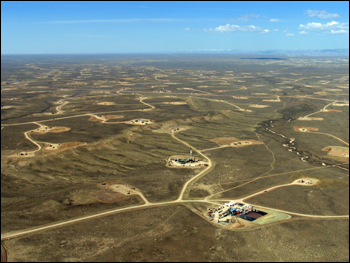The BREATHE Act
Congressman Jared Polis (D-CO) and Matt Cartwright (D-PA) have introduced H.R.1154, the Bringing Reductions to Energy's Airborne Toxic Health Effects (BREATHE) Act.
The BREATHE Act would close two exemptions in the Clean Air Act (CAA) that threaten the health of communities wrestling with oil and gas production in their backyard.
Oil & gas production's air pollution should be regulated by the Clean Air Act
Adopted in 1970, the Clean Air Act is the comprehensive federal law that regulates air pollution.
The CAA established limits for major pollution sources called the National Emission Standards for Hazardous Air Pollutants (NESHAPS).

Well pads in Wyoming's Jonah gas field stretch to horizon, yet are currently
exempt from regulation under the Clean Air Act. Consequently, air pollution in
parts of rural Wyoming is worse than in Los Angeles. The BREATHE Act would
fix this. Photo: SkyTruth
Smaller sources of pollutants that are
- controlled by a single operator,
- located close to each other, and
- perform similar functions
considered as one source of emissions. This aggregation allows for CAA oversight of smaller sources that, when concentrated, may actually be as harmful as larger sources.
This tool, aggregation under NESHAPS, is a perfect fit for regulating oil and gas drilling air pollution, which originates from clusters of wells (see image).
Oil & gas loopholes in the Clean Air Act
Unfortunately, the CAA exempts oil and gas wells, and in some instances pipeline compressors and pump stations, from aggregation under NESHAPS. This exemption allows the oil and gas production industry to pollute the air while largely unregulated by the CAA.
In addition, hydrogen sulfide was removed from the list of Hazardous Air Pollutants under the CAA in 1991. This elimination has remained despite a 1993 EPA study, Report to Congress on Hydrogen Sulfide Air Emissions Associated with the Extraction of Oil and Natural Gas, which clearly concludes that accidental releases of hydrogen sulfide during oil and gas development are a serious air quality concern and pose a great risk to public health.
Common symptoms of exposure to low levels of hydrogen sulfide can include headache, skin complications, respiratory problems and system damage, confusion, verbal impairment, and memory loss.
The BREATHE Act would apply the Clean Air Act to oil & gas production
The BREATHE Act closes both the NESHAPS and the hydrogen sulfide exemptions. Which would allow gaspatch residents to breath a sigh of relief.
For more information:
- Earthworks: Hydrogen Sulfide
- Earthworks: Statement of Earthworks Executive Director Jennifer Krill on today's introduction of the BREATHE and FRESHER Acts
- Colorado Independent: Polis follows up FRAC Act with BREATHE Act to strip clean air exemptions for gas drilling, March 18, 2011.
- Library of Congress: H.R. 1204 - the Bringing Reductions to Energy's Airborne Toxic Health Effects (BREATHE) Act.
- Representative Jared Polis: BREATHE fact sheet
Tagged with: regulation, polis, oil and gas, holt, hinchey, breathe act, air pollution
Follow Earthworks